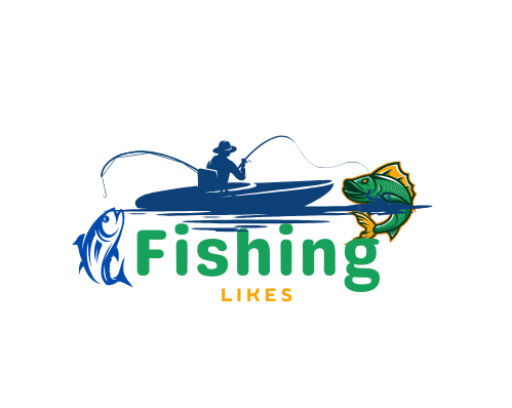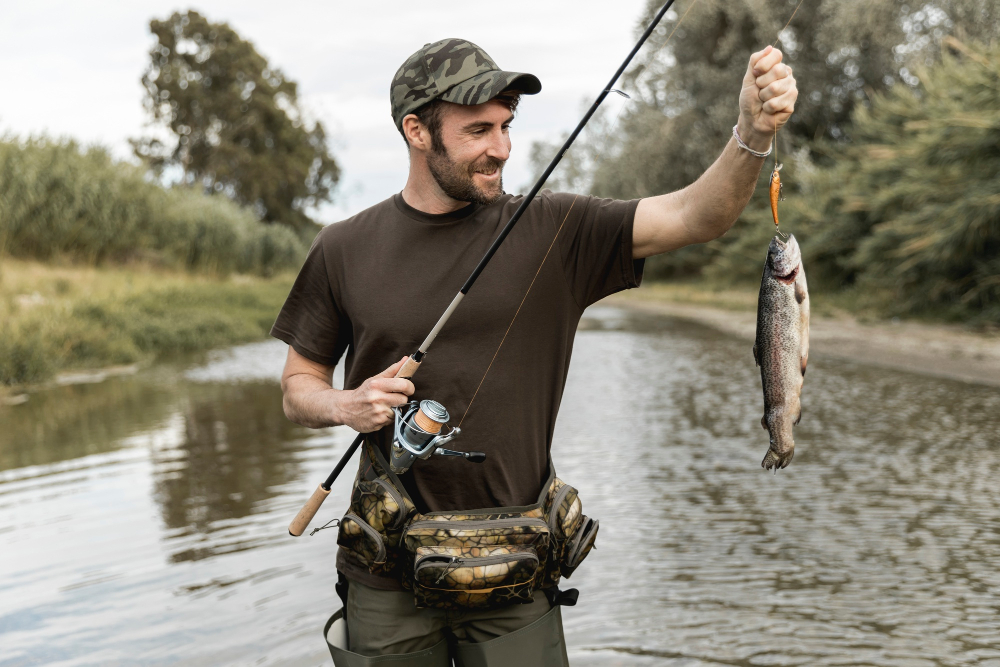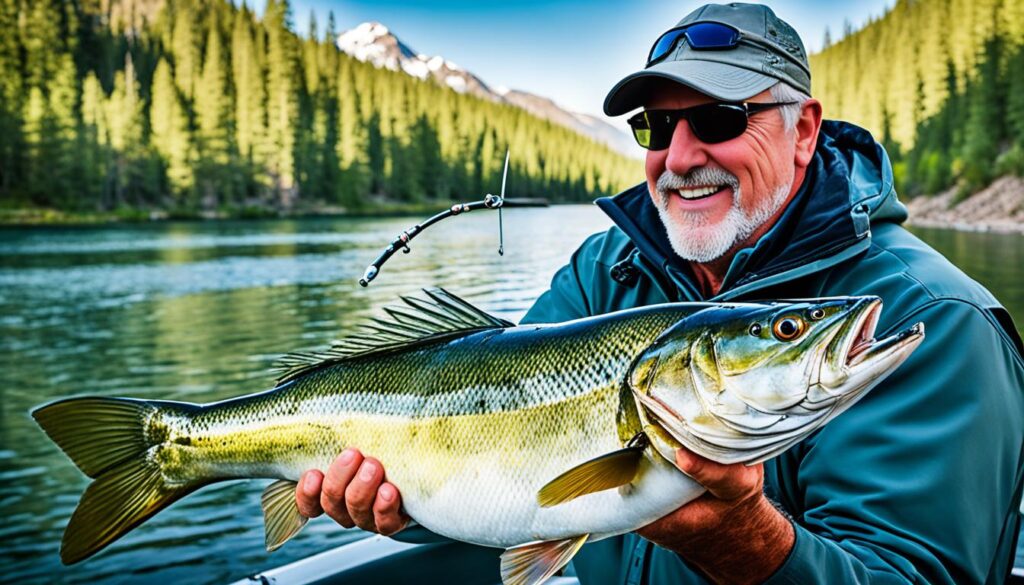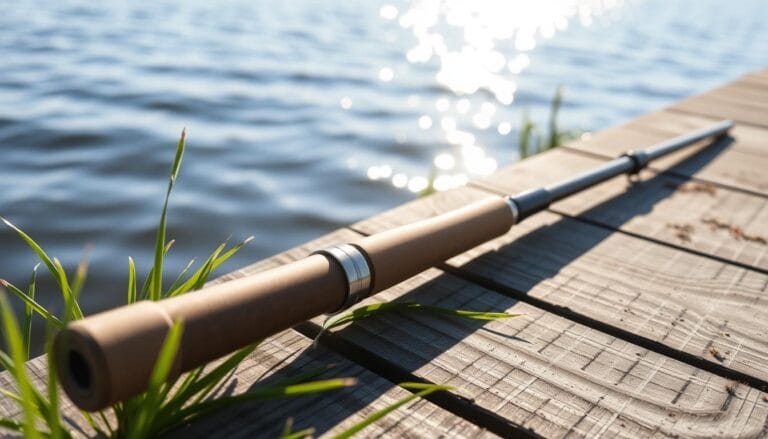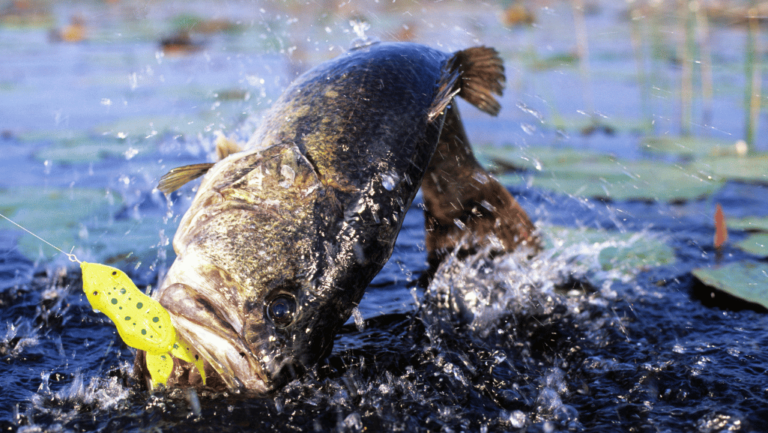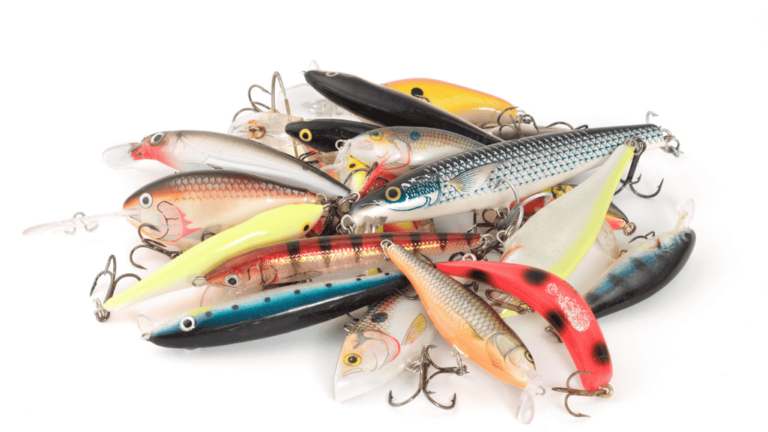Feeder fishing is changing the game for anglers. It uses a smart way to keep fish interested with a steady stream of bait. This method is loved by newbies and pros alike. It increases your chances of catching fish like carp, roach, and bream. Feeder fishing uses special feeders for creating a spot that keeps fish wanting more. It’s become a favorite for many because it blends clever moves with being patient.
Our guide will show you why feeder fishing works so well. It covers everything from choosing the right feeder to set up your rod. You’ll learn which feeders to pick for different fishing spots. And we’ll help you select the best gear for your kind of fishing. This means you can catch more in places like ponds or big carp lakes. Our guide will boost your feeder fishing skills and enjoyment.
Key Takeaways
- Feeder fishing is a popular method for catching species like carp, roach, and bream through continuous bait application.
- Various types of swim feeders serve different purposes, including the maggot feeder, groundbait feeder, and method feeder.
- Proper rod and tackle selection, such as light feeder or “picker” rods, is crucial for different fishing scenarios.
- Choosing the appropriate quiver tip and mastering rigging techniques can significantly improve fishing success.
- Feeder fishing combines strategic bait application with patience, making it an engaging and rewarding angling method.
What is Feeder Fishing?
Feeder fishing is a unique way to throw bait in the water. It keeps a constant flow of bait to a certain spot, making fish like carp stay and eat. This is unlike old fishing ways that used catapults or sticks to throw bait far.
Now, there are many different types of feeders. You have feeders that work like sinkers, to those that target specific fish like silver carp. These devices let fishermen cover more ground and use a variety of baits, making fishing fun and dynamic.
There’s a feeder for every fishing style. Whether you’re using maggots, groundbait, or corn, there’s a feeder for it. Some add weight to your line, some draw fish in, and others do both. This makes it great for catching fish like carp and catfish.
Choosing the right fishing rod is important in feeder fishing. You can pick from light or heavy rods, each for different fishing needs. Add in a special type of line called a quiver tip, and you’re ready for any situation. Not to mention, there are special setups for certain fish, making your chances of catching them even better.
Don’t forget the helicopter rig, a type of setup that helps you cast far without getting tangled. It’s perfect for going after barbel or tench. By learning about all these feeder fishing tools, you can do better in catching fish, no matter where you’re fishing.
Types of Feeders for Fishing
In the world of feeder fishing, various types of feeders can make your fishing experience better. Each type has its own use and works well in different conditions. It’s key to pick the right feeder for where you fish.
Understanding each feeder’s role helps you fish better. It lets you choose the best tactics to catch more fish. So, knowing your feeders is a big step towards fishing success.
Block-end Feeder (Maggot Feeder)
The Block-end Feeder, also known as the Maggot Feeder, is perfect for live baits like maggots. It’s great in rivers because it keeps bait in place longer. This helps draw more fish to your area.
Open-Ended Cage Feeder
Open-ended Cage Feeders are for quick groundbait release. They work in both shallow and deep waters. This feeder’s design makes bait look attractive to fish.
Cage Feeder
Cage Feeders also release groundbait fast. They’re good in any water depth, making them versatile. They’re ideal for different fishing situations.
Method Feeder
Method Feeders pack groundbait around a weight, which fish find hard to resist. They’re used where making bait extra attractive is important. Such venues come alive with the use of this feeder.
Feeder Bombs
Feeder Bombs are great for casting far. They drop their bait when hitting the water, drawing fish in. Use them in big waters like lakes and rivers for great results.
Alloy/Hybrid Feeder
Alloy or Hybrid Feeders are designed for better casting. They merge features from different feeders for a flexible tool. They work well in many fishing spots.
Pellet Feeder
Pellet Feeders are designed for soft baits. They keep your bait in good condition and more attractive. With the right gear, they can help you catch more fish.
| Feeder Type | Best For | Key Feature |
|---|---|---|
| Block-end Feeder | Running Water | Retains Bait Longer |
| Open-Ended Cage Feeder | All Water Depths | Fast Groundbait Release |
| Cage Feeder | Various Water Depths | Quick Groundbait Release |
| Method Feeder | High Attractiveness Venues | Pack Groundbait Around Core |
| Feeder Bombs | Long-Distance Casting | Immediate Bait Release |
| Alloy/Hybrid Feeder | Precision Baiting | Optimized Casting Design |
| Pellet Feeder | Soft Baits | Maintains Bait Condition |
Feeder Fishing Techniques and Tips
Feeder fishing is all about being precise and choosing the right bait. These tips for feeder fishing can really help you catch more fish. It’s a mix of knowing what to do, what to use, and being patient.
Casting Accuracy
Getting your cast just right is super important in feeder fishing. You want your bait to stay in one place to attract the fish. A 4lb mono line is great, especially for small skimmers, because it lets you cast with precision.
Bait Selection
Choosing the best bait matters a lot. Mixing 50% Mainline Method with 50% Thatcher’s Original really works well to bring in the fish. For the hook, go with something like dead red maggots. They’re bright and get the fish’s attention, good for bream.
Patience and Timing
Being patient is key in feeder fishing. Sometimes, if you’re quick with your bait, you can get bites within a minute. This works great with the ‘fast feeder’ method.
Rig-Tying Skills
Knowing how to tie your rigs well is very important. Use a 0.10mm or 0.12mm Garbo Line for the hook link. Start with a 50cm length and you might need to make it shorter to around 20cm once the fish start biting more often.
Using PVA Tape
PVA tape is great for controlling how fast your bait releases. It helps make sure there’s always food to keep the fish close. Try using a 25g feeder to get the bait down quickly, close to the lakebed.
| Technique | Details |
|---|---|
| Mono Line | Use 4lb mono line for small skimmers |
| Hooklink | 0.10mm or 0.12mm Garbo Line, 50cm to 20cm length |
| Feeder | 25g wire cage feeder for accuracy |
| Groundbait Mix | 50/50 blend of Mainline Method and Thatcher’s Original |
| Hook Baits | Two dead red maggots or three dead fluoro pinkies |
Setting Up Your Feeder Fishing Rig
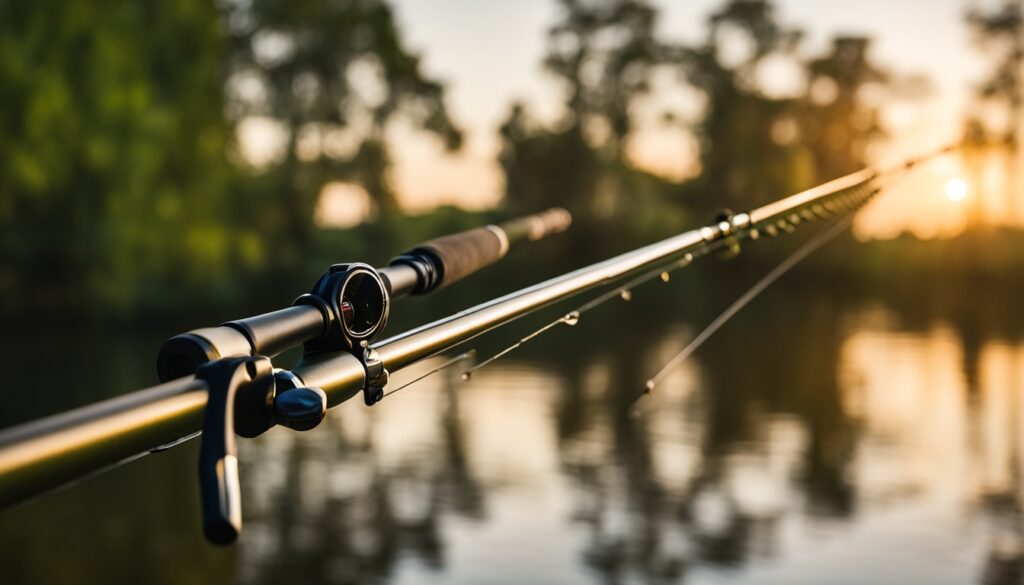
Creating a good feeder fishing rig is key to catching fish. You need the right gear, like the best rod and reel. Picking the right tools and setup can really help your fishing luck.
Begin with an appropriate rod. Think about the water you’ll be fishing in. You might need a light feeder rod for short distances. Or maybe a heavy one for big baits. The CS5 4000 Match Reel is a smart choice for its flexibility.
Picking the right bait is crucial too. Each type of bait works better with certain feeders. Use maggots, pellets, or groundbait. If the water is still, a Guru Gripper feeder can help your bait work better. And methods feeders make your bait look more tempting.
Don’t forget about tying the rig. It’s important to tie it well. This makes sure your rig stays strong and does its job right. Guru Quick Change Speed Beads are great for making fast changes to your setup.
Your fishing line choice is also very important. In the winter, go for lighter lines like the Preston Reflo Sinking Feeder Mono. But in the summer, use stronger lines, for example, 8lb 0.26mm.
Picking the right hooks is crucial too. Make sure your hook is 1 to 2 feet long. But, you might need to change this length depending on the fishing spot. Good hooks like Guru QM1 4″ can help you catch more fish.
- Avoid recasting frequently; wait about 10 minutes before casting again.
- Top up your bait every hour to maintain fish interest.
Setting your feeder fishing rig up well increases your chances of catching fish. It doesn’t matter if you’re fishing in a lake, river, or fishery. Paying attention to your setup details can make your fishing trip successful and fun.
Feeder Fishing Setup Essentials
To succeed at feeder fishing, choosing the right gear is key. You should pick the best rod, reel, and line and hook set for the fishing spot. This requires thinking about your fishing conditions carefully.
Choosing the Right Rod
The first thing to get right is your fishing rod. The type of water you fish in really matters here. For calm waters like ponds, you’ll want a rod with a lighter tip, about 0.75 to 1 oz.
For bigger lakes and streams with more movement, go for a 1 to 2 oz tip. Rivers need even stronger rods, from 2 to 6 oz. If you’re on a fast river with tough fish, you might need a rod with a 3 to 5 oz tip. The right rod helps you cast better and feel when you’ve caught a fish.
Selecting the Right Reel
After the rod, choosing the right reel is crucial. Feeder fishing on large rivers needs bigger reels, like those sized 6000 to 10000. These bigger reels help you handle tougher fishing situations.
When picking your reel, think about using braided line. It makes it easier to feel when a fish is interested, especially in cold water. This can make a big difference in your fishing success.
Line and Hook Choices
Lastly, you need to choose the best line and hooks. Go for high-quality gear like the Preston Reflo Powerline for your hook link. It’s known for being strong.
Start with a size 14 hook for small baits, like bits of worm or double maggot. Move to a size 10 hook for larger baits, such as hair-rigged corn. Adding a fluorocarbon hooklength makes your bait look more natural and less likely to tangle, improving your fishing chances.
| Fishing Environment | Tip Strength (oz) | Reel Size | Recommended Line | Hook Size |
|---|---|---|---|---|
| Ponds/Calm Channels | 0.75 – 1 oz | 5000 – 6000 | Fluorocarbon | 14 LWGF |
| Deeper Lakes/Channels | 1 – 2 oz | 6000 – 8000 | Braid | 12 LWGF |
| Rivers | 2 – 6 oz | 6000 – 10000 | Fluorocarbon | 10 MGWB |
| Fast Rivers with Fighting Fish | 3 – 5 oz | 8000 – 10000 | Braid | 10 MGWB |
Best Feeder Fishing Gear
Anglers with lots of experience recommend a range of feeder fishing gear for success. You’ll find different feeders for various river types and fishing methods. For example, spare tips for your fishing rod help you cope with different water flows. This improves your fishing outings.
Start your search for the best angling gear with the right reel. In general, experts suggest using bigger reels, sized 6000 to 10000, for fishing in rivers. Combining these with the trusted Preston Reflo Powerline hook link leads to great catches.
Worms are a fantastic bait choice. Use a Cresta EVA bait bag to keep them fresh. And, Cresta worm Scissors help when you need chopped worms to attract fish. A good groundbait, like the Sonubaits Deep Water mix, is also great for river fishing. It makes your bait spread easier and keeps the fish interested.
If you wear polarized sunglasses, you’ll see through water glare better. This makes it easier to find fish and avoid headaches on long fishing days. These fishing accessories boost your comfort and focus when trying to catch fish.
| Gear Type | Brand | Recommendation |
|---|---|---|
| Feeder Selection | Various Brands | Diverse weights and tube sizes |
| Rod Tips | Various Brands | Spare for different conditions |
| Reels | Various Brands | 6000 to 10000 size range |
| Hook Links | Preston | Reflo Powerline |
| Live Bait Storage | Cresta | EVA Micro Mesh Bait Bag |
| Chop Worms | Cresta | Worm Scissors |
| Groundbait | Sonubaits | Deep Water Mix |
| Sunglasses | Various Brands | Polarized for glare reduction |
This fishing gear guide brings together key advice and fishing accessories. It helps feeder fishing enthusiasts at all levels.
How to Rig a Feeder for Fishing
Feeder fishing is becoming popular with anglers around the globe. It’s great for making bait look good and catching many types of fish. By choosing the right fishing rig types, you can get better at fishing. This article explains the various ways to set up your feeder rig for different fishing needs.
Running Rig
The Running Rig is very versatile and works in places with lots of fish. It lets the line move easily when a fish bites, which helps catch fish like carp and catfish. These fish like baits such as dough or particle baits.
Captive Running Rig
This rig helps you wait to catch the fish that nibbles first. The Captive Running Rig is great at showing when a fish is biting. It’s used a lot in Europe and Asia, and now in North America too.
Paternoster Rig
The Paternoster Rig is great at spotting fish bites. It’s best for fishing without moving, for fish like carp. This rig stops the bait from getting stuck on the bottom. You can use bread, bird seed, and corn to make your bait attractive.
Method Feeder Rig
The Method Feeder Rig helps you fish without getting your lines tangled. It spreads a strong scent in the water to attract fish quickly. By using special feeders like those from Angler’s Emporium, you can feed fish well.
Helicopter Feeder Rig
Great for rivers and many types of fish, the Helicopter Feeder Rig reduces tangles. It uses maggot or corn baits, especially for Asian carp. Use a 1:1 bait to water mix for a steady flow of bait that fish can’t resist.
Learn these rigging for fishing feeders well to catch more fish. Choose the best rig for the type of fish and where you’re fishing. This way, you’ll have more fishing success.
Feeder Fishing for Beginners
Starting out in feeder fishing is a mix of fun and hard work. We have a lot of important advice for feeder fishing beginners. You’ll learn what to do, what not to do, and the gear you’ll need.
Basic Tips for New Anglers
Here’s some top advice for those new to fishing. First up, pick the right swim feeder. If you’re using live bait, go for a maggot feeder. For groundbaits, go with an open-end feeder. This choice is key for successful angling.
For your rod, a light 7-10ft feeder type works best. This size makes sure you feel the bites. It’s also smart to get good at casting accurately early on. Beginners should use a setup with 3-5lb lines for these lighter rods.
Common Mistakes to Avoid
New anglers often make a couple of common mistakes. One of these is to not match the rod with the right feeder weight. You should use light feeders, about 25g, with light rods to cast well and feel the bites.
Another error is not baiting right. Mix your groundbait with things like casters and dead maggots to attract more fish. And remember, moving around too much is a no-go. Stay put after casting your feeder; the best time to catch fish is often right away.
Essential Gear for Starters
Here’s what you need to get started with feeder fishing:
- Rods: Light feeder rods (7-10ft) are best for newbies.
- Lines: Choose 4lb mono for lighter catches.
- Feeders: The right choice is a 25g wire cage feeder for efficient baiting.
- Hooks: Pick Size 16 or 18 Kamasan B911 F1 for tough situations.
- Bait: A mix of 50/50 Mainline Method and Thatcher’s Original with dead red maggots or fluoro pinkies works well.
Getting the right starter gear will help you catch more fish. It’s crucial for beginners to have the best start to their fishing adventure.
| Gear Component | Recommended Specification |
|---|---|
| Rods | Light feeder rods (7-10ft) |
| Lines | 4lb mono |
| Feeders | 25g wire cage feeder |
| Hooks | Size 16 or 18 Kamasan B911 F1 |
| Bait | 50/50 Mainline Method and Thatcher’s Original with dead red maggots or fluoro pinkies |
Choosing the Right Feeder Fishing Bait
Choosing the best bait for feeder fishing is key to catching fish. Maggots, pellets, and groundbait are top choices. Knowing how and when to use them makes a big difference for anglers.
Maggots
Maggots work well for many types of fish. When picking them, think about the fish you’re after and the weather. Choose fresh maggots for fish like roach and bream.
In cold weather, use red maggots. They stand out better in dark water.
Pellets
Pellets are now a favorite for feeder fishing fans. They’re great for Method fishing. This is where you use soft micro pellets to attract fish. Carp and bream really like them.
To make pellets even better, add attractants like Mainline’s Bait Syrups. This is especially helpful in matches.
Groundbait
Groundbait creates a meal in the water to draw fish to your area. You can mix it to target certain types of fish. For example, use sweet corn for tench or crushed seeds for roach.
How much and what groundbait you use depends on the water and weather. Mix it up with pellets for more variety in your fishing.
Remember, the right bait choice depends on your fishing spot and the weather. Knowing what to use and when helps you catch more fish.
Feeder Fishing Rod and Reel: A Comprehensive Guide
Picking the best feeder fishing rod and reel is key for good fishing. This comprehensive guide will talk about different rods and reels. It helps you choose wisely for your fishing needs.
Feeder rods are usually 9 to 13 feet long. This length helps you cast further and control your line better. You can choose from models like the Drennan Red Range 11ft Method Feeder Rod or the Shimano Aero X1 Precision Feeder Rod. They are well-known in fishing and work for many types of fishing trips.
- Rod Specifications:
- The Discover Feeder Fishing Rod is rated for lines from 3lb to 8lb, fitting many fishing plans.
- You can cast weights from 28g to 85g with it, great for different techniques and fish types.
- It comes with 1oz and 2oz fiberglass quivertips, useful for various fishing needs.
Choosing the right fishing reel is just as essential. Look for a feeder reel with a medium to large spool for far casting. This helps you fish more effectively. Many anglers use a braided mainline with a mono or fluorocarbon leader. This combo is strong and sensitive.
Learn techniques like overhead and side casting to cast more accurately. Consistent feeding keeps the fish interested, helping you catch more. Adjust the amount of feed based on fish response and the fishing spot.
The Discover Feeder Fishing Rod has features that make it great for fishing. It has guides that lower line friction for better, longer casts. Plus, it has a reel seat that’s good for holding in wet conditions. The cork/EVA handle is comfy and works in all weather.
Knowing about different rods and reels helps you pick better. Right equipment improves your fishing adventure. It becomes more fun and productive.
North East Tackle Supplies has a lot of good terminal tackle for your feeder rigs. The Discover Feeder Fishing Rod is light but strong, balancing power with sensitivity. It comes with a 24T Carbon blank that’s perfect for various fishing styles.
Feeder Fishing Lakes and Locations
Feeder fishing is a favorite way to fish for many. Knowing where the best places are for feeder fishing helps a lot. It’s also key to know the local fishing rules and when it’s best to fish during the year.
Popular Lakes for Feeder Fishing
In High Heyes Fishery, England, you’ll find a good mix of fish like tench and carp. Hayfield Lakes in Doncaster, England, especially Dannie’s Island Lake, is great for feeder fishing too. Hallcroft Fishery in Retford is famous for big carp, skimmers, and bream.
In Manor Farm Leisure, England, Island Pool is a good spot with carp and tench. Head Fen Lakes in Ely is perfect for using worms and maggots with a variety of fish. Larford Lakes near Stourport is known for its big carp and quality bream. Boddington Reservoir in Northamptonshire is a top spot for catching massive carp.
Important Local Regulations
Knowing the rules for the fishing spots you visit is crucial. Rules could include needing a fishing license or catch limits. It’s important to check the regulations for each lake to protect the fish.
Best Seasons for Various Species
Understanding when different fish are most active is very useful. Spring and summer are good for fishing for tench, carp, and bream. Autumn can be a wonderful time for finding big carp close to the shore. Winter can work too, with the right strategies for your spot. Matching your trip to the best seasons increases your chance of having a good fishing day.
Conclusion
This guide thoroughly explored feeder fishing, covering techniques, gear, and strategies for better fishing. It’s designed for both new anglers and experienced fishers. It explains the importance of choosing the right feeder, presenting bait accurately, and using the best gear. These details can make a big difference in your fishing.
The method feeder and swim feeders are key in Carp fishing. They change how we fish. They’re great for still waters and food-rich rivers. Also, the feeder’s weight matters a lot. It affects how far you can cast and how well it hooks fish.
Feeder fishing isn’t as flashy as float fishing, but it’s effective. It lets you put bait in the same spot every time. This attracts more fish. Knowing the best rigs, baits, and feeders can make your fishing experience much better. For more on feeder fishing, check out feeder fishing hook bait and feed together.
